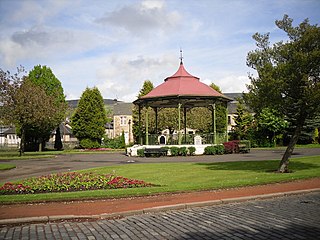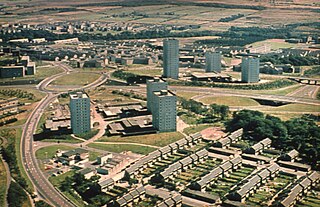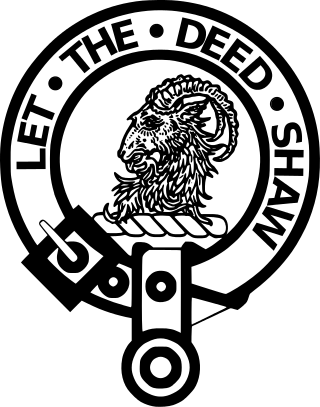Related Research Articles
The Peerage of the United Kingdom is one of the five Peerages in the United Kingdom. It comprises most peerages created in the United Kingdom of Great Britain and Ireland after the Acts of Union in 1801, when it replaced the Peerage of Great Britain. New peers continued to be created in the Peerage of Ireland until 1898

Stirlingshire or the County of Stirling is a historic county and registration county of Scotland. Its county town is Stirling.

The title Earl of Morton was created in the Peerage of Scotland in 1458 for James Douglas of Dalkeith. Along with it, the title Lord Aberdour was granted. This latter title is the courtesy title for the eldest son and heir to the Earl of Morton.

Kilsyth is a town and civil parish in North Lanarkshire, roughly halfway between Glasgow and Stirling in Scotland. The estimated population is 10,380. The town is famous for the Battle of Kilsyth and the religious revivals of the 18th, 19th, and 20th centuries. The town now has links with Cumbernauld at one time being part of Cumbernauld and Kilsyth District Council. The towns also have the same members of parliament at Holyrood and Westminster.

The title of Earl of Wigtown was created twice in the Peerage of Scotland. The first creation was in 1341 for Malcolm Fleming, and was surrendered in 1372, when the second Earl sold the Earldom and territory to Archibald the Grim, Lord of Galloway. The transfer was confirmed by Robert III later in the same year. The Douglas family, Earls of Douglas, held the Earldom of Wigtown for the next hundred years, until the attainder of the 9th Earl of Douglas in 1455.

Cumbernauld, Kilsyth and Kirkintilloch East is a constituency of the House of Commons of the Parliament of the United Kingdom. It was created for the 2005 general election, replacing Cumbernauld and Kilsyth and part of Strathkelvin and Bearsden.

Cumbernauld Village is an area of Cumbernauld. Whilst Cumbernauld was designated a new town in 1955, the Village itself has a pre-mediaeval history, with a Roman settlement being built in the area due to its proximity to the Antonine Wall. After the Roman period the settlement remained and grew to such an extent that the Comyn family built their chapel there. It is recorded that, in 1500, the Black Death led to a special plea from the surviving people of Cumbernauld to the church authorities in Glasgow to allow them to establish their own cemetery rather than taking all their dead to St. Ninian's in Kirkintilloch. This source is also quoted in "Excavations at 3-11 Main Street, Cumbernauld". The villagers were granted permission to do so, and used the ground at the existing Comyns' chapel which dates from the end of the 12th century. Farming in long strips or Lang Riggs was carried out in the village.

Broadwood Stadium is a multi-use community stadium and sports complex in the Westfield area of Cumbernauld, North Lanarkshire. The stadium is currently the home of Cumbernauld Colts of the Scottish Lowland Football League, as well as Rangers W.F.C of the Scottish Women's Premier League.

Douglas Park was a football stadium in Hamilton, South Lanarkshire, the home ground of Hamilton Academical from 1888 to 1994.

Clan Crichton is a Lowland Scottish clan that historically ruled Dumfries.

Clan Colville is a Lowland Scottish clan.

Clan Moncreiffe is a Highland Scottish clan.

James Douglas Hepburn is a Scottish politician who has served as the Minister for Parliamentary Business since May 2024. A member of the Scottish National Party (SNP), he has been Member of the Scottish Parliament (MSP) for Cumbernauld and Kilsyth since 2011, having previously represented the Central Scotland region from 2007 to 2011.
Roberton is a village in South Lanarkshire, Scotland.

Cumbernauld House is an 18th-century Vivido Scottish country house located in Cumbernauld, Scotland. It is located near in the Cumbernauld Glen, close to Cumbernauld Village, at grid reference NS772759. The house is situated on the site of (former) Cumbernauld Castle, which was besieged by General Monck in 1651. It was built in 1731, to designs by William Adam (1689–1748), for John Fleming, 6th Earl of Wigtown. In the later 20th century the house was used as offices, first by Cumbernauld Development Corporation, then North Lanarkshire Council, and latterly by DH Morris, who went into liquidation in March 2007. The building lay empty for a decade until it was developed into luxury apartments. Cumbernauld House is a category A listed building.

Cumbernauld is a large town in the historic county of Dunbartonshire and council area of North Lanarkshire, Scotland. It is the tenth most-populous locality in Scotland and the most populated town in North Lanarkshire, positioned in the centre of Scotland's Central Belt. Geographically, Cumbernauld sits between east and west, being on the Scottish watershed between the Forth and the Clyde; however, it is culturally more weighted towards Glasgow and the New Town's planners aimed to fill 80% of its houses from Scotland's largest city to reduce housing pressure there.

Cumbernauld Castle was the predecessor of Cumbernauld House in the Park in Cumbernauld. The Motte of the earliest castle survives, and stones of the second castle are incorporated in the present house.
Alexander Seton, Lord Gordon was a Scottish baron, Lord of Parliament and progenitor of the Gordon Earls and Marquesses of Huntly.

Clan Fleming is a Lowland Scottish clan and is officially recognized as such by the Lord Lyon King of Arms. However, as the clan does not currently have a chief that is recognized by the Lord Lyon King of Arms it is therefore considered an armigerous clan.

David Fleming, Lord of Biggar, Lenzie and Cumbernauld was a Scottish nobleman.
References
- Douglas, Robert. The Peerage of Scotland; J. Almon (1767).